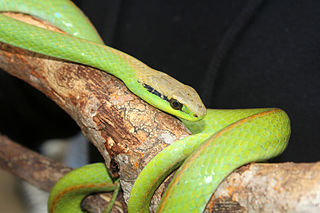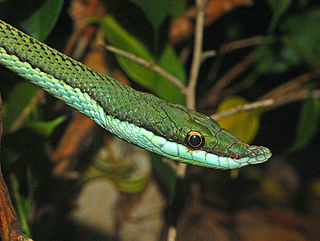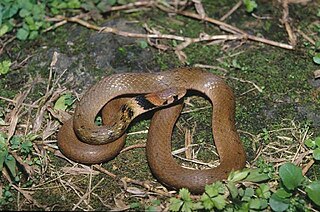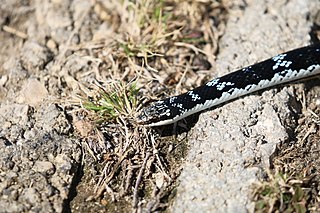Atractus trilineatus, commonly known as the three-lined ground snake, is a species of small burrowing snake in the family Colubridae. The species is native to South America.

Oxyrhopus petolarius, commonly known as the forest flame snake, is a species of snake in the family Colubridae. The species is endemic to South America. There are three recognized subspecies.
Philodryas is a genus of colubrid snakes endemic to South America, commonly called green snakes.

The viperine water snake or viperine snake is a semiaquatic, fish-eating natricine water snake. Despite its common names, it is not a member of the subfamily Viperinae. It was given its common names due to exhibiting a dorsal colour pattern that superficially resembles that of sympatric adder species. In comparison to other Natrix species its head is also somewhat wider and more distinct from the neck. Like most members of the Natricinae it possesses a venom gland on each side of the upper jaw that produces a mild venom that may play a role in swallowing or digestion. The gland is not associated with an enlarged specialized tooth and the venom has to be applied by chewing. The species usually does not bite as a means of defense, and the effect of a bite would be harmless to humans.
The Saint Croix racer is a possibly extinct species of snake in the family Colubridae that is endemic to the island of Saint Croix in the United States Virgin Islands.
The spatula-toothed snake is a species of snake in the family Colubridae. The species is endemic to Indonesia.

Goldie's tree cobra, also known commonly as the African tree cobra and as Gold's tree cobra, is a species of venomous tree cobra in the family Elapidae. The species is native to Central and Western Africa. This species is one of the two tree cobras in Africa, the other being the black tree cobra. Goldie's tree cobra is one of the most venomous snakes and creatures in Africa.

Boiga barnesii is a species of cat snake endemic to Sri Lanka. It is known as Barnes' cat snake in English and panduru mapila-පදුරු මාපිලා in Sinhala. It is a member of the snake family Colubridae. It is distributed in the lowlands and midlands up to approximately 600 m (2,000 ft) above sea level, with known localities include Matale, Kandy, Gannoruwa, Gampola, Ambagamuwa, Balangoda, Labugama and Sinharaja Rain Forest. Barnes' cat snake is mainly a forest-dwelling species but may occasionally be found in human habitats. It is the smallest cat snake in Sri Lanka and grows up to a maximum of about 600 mm (24 in) in snout-vent length. Being a nocturnal and an arboreal hunter, it mainly feeds on agamid lizards and geckos. The day time is usually spent inside a tree hole or a crevice. It’s a very timid and a mildly venomous snake and rarely attempts to bite.

Tachymenis is a genus of venomous snakes belonging to the family Colubridae. Species in the genus Tachymenis are commonly known as slender snakes or short-tailed snakes and are primarily found in southern South America. Tachymenis are rear-fanged (opisthoglyphous) and are capable of producing a medically significant bite, with at least one species, T. peruviana, responsible for human fatalities.

Julia's ground snake is a species of snake in the family Colubridae. The species is found in the Caribbean, on the Lesser Antilles islands of Dominica and Guadeloupe.
Shaw's dark ground snake, also known commonly as Shaw's black-backed snake, and in Spanish as candelilla, guarda caminos, and reinita cazadora, is a species of snake in the family Colubridae. The species is native to northern South America.

Aspidelaps lubricus, commonly known as the Cape coral snake, Cape coral cobra or Coral Shield Cobra, is a species of venomous snake in the family Elapidae. The species is endemic to southern Africa.

Philodryas olfersii is a species of venomous snake in the family Colubridae. The species is endemic to South America.

Philodryas baroni, common name Baron's green racer, is a species of rear-fanged venomous snake in the family Colubridae. The species is endemic to South America.

Rhabdophis swinhonis is a species of snake in the subfamily Natricinae of the family Colubridae. The species is endemic to Taiwan. It is also known commonly as the Taiwan keelback and Swinhoe's grass snake.

Anderson's stream snake, also known commonly as Anderson's mountain keelback, is a species of snake in the family Colubridae. The species is native to Asia

Caraiba is a monotypic genus of snakes in the family Colubridae. The genus contains the sole species Caraiba andreae, also known commonly as the black and white racer or the Cuban lesser racer, which is endemic to Cuba. There are six recognized subspecies.
The ridgehead snake is a species of snake in the family Colubridae. The species is endemic to southeastern Mexico.
The bluebelly Java snake, also known commonly as Fruhstorfer's mountain snake and the Javan bluebelly snake, is a species of snake in the family Colubridae. The species, which is the only member of the genus Tetralepis, is endemic to Java.
Rhadinella godmani, also known commonly as Godman's graceful brown snake, and as la culebra-café de Godman and la lagartijerita de Godman in American Spanish, is a species of snake in the family Colubridae. The species is native to Central America and southern Mexico. There are two recognized subspecies.














